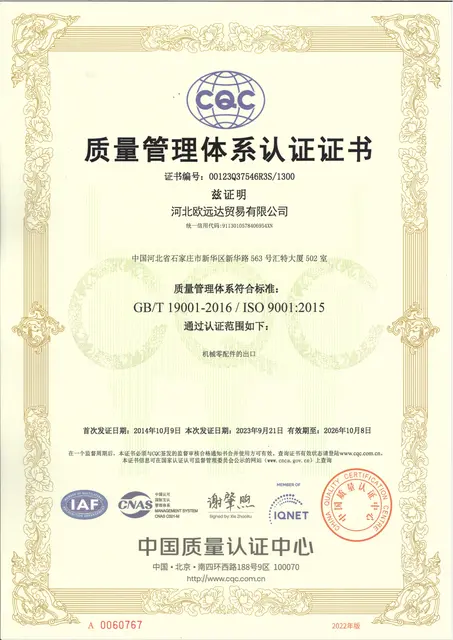Mobile:+86-311-808-126-83
Email:info@ydcastings.com
English
stirrer impeller
Understanding Stirrer Impellers Design, Function, and Applications
Stirrer impellers are critical components in various industrial processes, particularly in mixing operations. These devices are designed to provide agitation to a fluid, enabling the effective mixing of different substances. Whether in the food, pharmaceutical, chemical, or wastewater treatment industries, stirrer impellers play a vital role in ensuring uniformity, enhancing reaction rates, and promoting heat and mass transfer.
The Basic Design of Stirrer Impellers
Stirrer impellers come in various shapes and sizes, each suited for specific applications. The most common types are
1. Propeller Impellers These are designed with blades that resemble a boat propeller. They are excellent for mixing low-viscosity fluids and are typically mounted on a shaft to rotate and create flow.
2. Turbine Impellers Featuring multiple flat blades, turbine impellers are effective for mixing higher-viscosity fluids. They can create both axial and radial flow, ensuring thorough mixing throughout the tank.
3. Anchor Impellers These are used for highly viscous fluids and pastes. The shape of the anchor allows it to scrape the walls of the tank, helping to move the material back into the main flow.
4. Paddle Impellers These are used for gentle mixing and are suitable for food and pharmaceutical applications. They create moderate shear and are effective for suspending solid particles in liquids.
The choice of impeller type depends on various factors, including the viscosity of the fluid being mixed, the desired flow pattern, and the specific characteristics of the materials involved.
Functionality and Working Principles
The primary function of a stirrer impeller is to create flow and turbulence within a mixing vessel. As the impeller rotates, it imparts energy to the fluid, causing it to move in a specific direction. This movement promotes the interaction of different components, facilitating processes such as dissolution, emulsification, and chemical reactions.
In designing an effective stirrer impeller system, engineers must consider several parameters
stirrer impeller

- Rotation Speed The speed at which the impeller rotates can significantly impact the mixing efficiency. Higher speeds may lead to increased shear forces, which can be beneficial or detrimental depending on the materials being mixed.
- Impeller Diameter A larger diameter can enhance mixing in a tank, but it may also create excessive shear, adversely affecting delicate materials.
- Tank Geometry The shape and size of the mixing tank influence the flow patterns generated by the impeller. Clear understanding of tank geometry is crucial for optimizing the mixing process.
Applications of Stirrer Impellers
Stirrer impellers find applications in a wide range of industries
1. Chemical Manufacturing They are employed for blending, dispersing chemicals, and increasing reaction rates in various chemical processes.
2. Food and Beverage Production In the food industry, stirrer impellers are used to mix ingredients, emulsify oils and water, and create uniform texture in products like sauces and dressings.
3. Pharmaceuticals The gentle mixing provided by specific impellers is crucial for maintaining the integrity of active ingredients in drug formulations.
4. Wastewater Treatment Stirrer impellers are vital in aeration tanks and other treatment processes, promoting the uniform distribution of microorganisms and chemicals.
5. Cosmetics and Personal Care They are used to blend and emulsify various ingredients in lotions, creams, and other products, ensuring a consistent product quality.
Conclusion
Stirrer impellers are indispensable tools in industrial mixing applications. Their versatility in design and functionality enables them to cater to a wide array of processes across different sectors. Understanding the principles behind their operation and selecting the appropriate type of impeller is essential for achieving optimal mixing results. As industries evolve and demand for efficient mixing solutions increases, stirrer impellers will continue to play a vital role in enhancing productivity and product quality.
-
Materials Used in Manufacturing Cap End Pipe FittingsNewsNov.24,2025
-
Material Properties of CF8M CastingNewsNov.24,2025
-
How to Inspect Pump Cap Ends for DamageNewsNov.21,2025
-
Backward Curved Impeller – Efficient Airflow Solutions for Industry | YD CastingsNewsNov.21,2025
-
Automobile Water Pump - Efficient, Quiet, Durable & ElectricNewsNov.21,2025
-
Impeller for Pumps – High-Efficiency, Durable, OEM-ReadyNewsNov.21,2025











